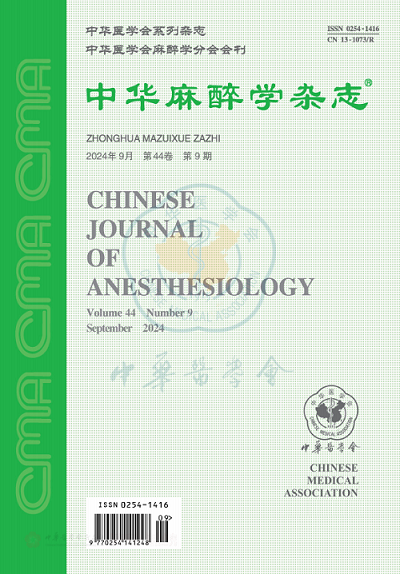Effect of remifentanil on MACBAR of sevoflurane in patients with hepatic dysfunction undergoing laparoscopic surgery
Q4 Medicine
引用次数: 0
Abstract
Objective To evaluate the effect of remifentanil on the minimum alveolar concentration of sevoflurane required to blunt the adrenergic response (MACBAR) in the patients with hepatic dysfunction undergoing laparoscopic surgery. Methods The patients, aged 18-64 yr, with body mass index < 30 kg/m2, undergoing elective laparoscopic hepatobiliary surgery, were selected.Patients with normal liver function were selected as control group (C group), and patients with liver dysfunction (Child-Pugh grade B) were selected as test group and divided into 3 subgroups by a random number table method: no remifentanil group (R0 group) and different target plasma concentrations of remifentanil groups (R1 group and R2 group). Anesthesia was induced by intravenously injecting propofol 2-3 mg/kg, remifentanil 2 μg/kg and cisatracurium 0.15 mg/kg.After endotracheal intubation, mechanical ventilation was performed.The end-tidal sevoflurane concentration was adjusted to the preset concentration in each group and maintained at the level for 20 min before the pneumoperitoneum was established.Anesthesia was maintained as follows: remifentanil was not used in C group and R0 group, and the target plasma concentration of remifentanil was 1 and 2 ng/ml in group R1 and group R2, respectively, and sevoflurane was inhaled.The MACBAR of sevoflurane was determined using the sequential method.The initial end-tidal sevoflurane concentrations were 5.0%, 4.6%, 2.6% and 2.4% in group C, group R0, group R1 and group R2, respectively.MAP and HR were recorded and blood samples were collected before and after pneumoperitoneum, and the plasma epinephrine and norepinephrine concentrations were measured by enzyme-linked immunosorbent assay, and the difference in MAP and HR before and after pneumoperitoneum was calculated. Results A total of 14 cases in group C, 19 cases in group R0, 19 cases in group R1 and 15 cases in group R2 completed the study.Compared with group C, the MACBAR of sevoflurane and plasma adrenergic concentration before and after pneumoperitoneum were significantly decreased (P 0.05). Compared with group R0, the MACBAR of sevoflurane was significantly decreased in group R1 and group R2, and HR before and after pneumoperitoneum and the difference were significantly decreased in group R2(P<0.05). The MACBAR of sevoflurane was significantly lower in group R2 than in group R1 (P<0.05). Conclusion Remifentanil can decrease the MACBAR of sevoflurane and enhance the efficacy in inhibiting the stress responses in the patients with hepatic dysfunction undergoing laparoscopic surgery. Key words: Anesthetics, inhalation; Piperidines; Hepatic insufficiency; Dose-response relationship, drug瑞芬太尼对腹腔镜手术肝功能不全患者七氟醚MACBAR的影响
目的探讨瑞芬太尼对肝功能不全腹腔镜手术患者肾上腺素能反应(MACBAR)所需七氟醚最低肺泡浓度的影响。方法选择年龄18 ~ 64岁,体重指数< 30 kg/m2的择期腹腔镜肝胆手术患者。选择肝功能正常患者作为对照组(C组),选择肝功能不全患者(Child-Pugh分级B级)作为试验组,采用随机数字表法分为无瑞芬太尼组(R0组)和不同瑞芬太尼靶血药浓度组(R1组和R2组)3个亚组。麻醉方式为静脉注射异丙酚2 ~ 3 mg/kg、瑞芬太尼2 μg/kg、顺阿曲库铵0.15 mg/kg。气管插管后行机械通气。将各组潮末七氟醚浓度调整至预设浓度,并在此水平上维持20 min,然后建立气腹。麻醉维持如下:C组和R0组不使用瑞芬太尼,R1组和R2组瑞芬太尼靶血药浓度分别为1和2 ng/ml,吸入七氟醚。采用序贯法测定了七氟醚的MACBAR。初始潮末七氟醚浓度在C组、R0组、R1组和R2组分别为5.0%、4.6%、2.6%和2.4%。记录MAP和HR,取气腹前后血液标本,采用酶联免疫吸附法测定血浆肾上腺素和去甲肾上腺素浓度,计算气腹前后MAP和HR的差异。结果C组14例,R0组19例,R1组19例,R2组15例完成研究。与C组比较,气腹前后七氟醚MACBAR及血浆肾上腺素能浓度均显著降低(P < 0.05)。与R0组比较,R1组和R2组七氟醚的MACBAR显著降低,R2组气腹前后HR显著降低,差异均有统计学意义(P<0.05)。R2组七氟醚的MACBAR显著低于R1组(P<0.05)。结论瑞芬太尼可降低七氟醚的MACBAR,增强对肝功能障碍腹腔镜手术患者应激反应的抑制作用。关键词:麻醉药;吸入;哌啶;肝功能不全;剂量-反应关系,药物
本文章由计算机程序翻译,如有差异,请以英文原文为准。
求助全文
约1分钟内获得全文
求助全文

 求助内容:
求助内容: 应助结果提醒方式:
应助结果提醒方式:


